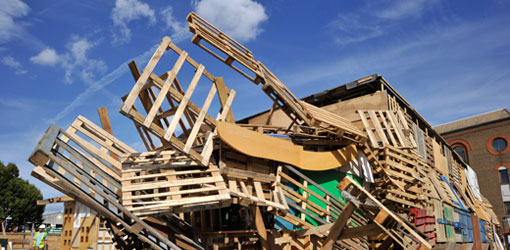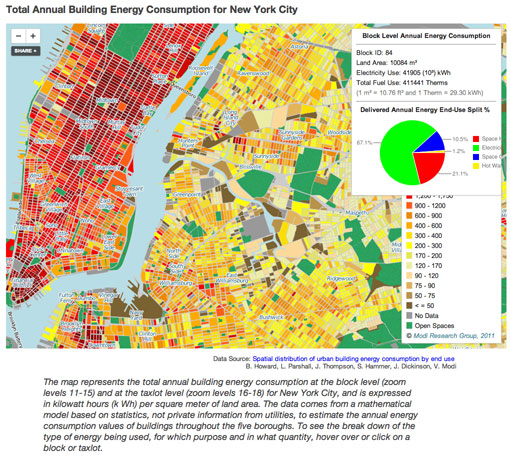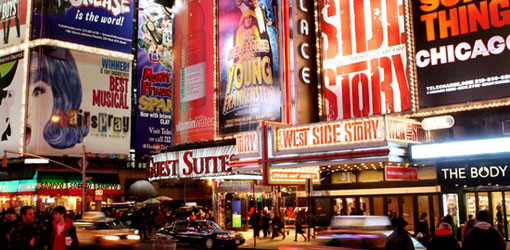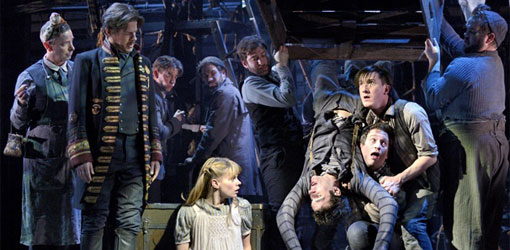Heavy Theatre in the Big Apple
Posted on October 26, 2012 | posted by:
In reading John Thackara’s In The Bubble, he often speaks of our decreasing lightness in what was supposed to be a new weightless economy brought upon by the advent of the Internet. “…man-made flows of matter and energy all around us are growing in volume. We buy more hardware than ever. We print more paper. We package more goods. We move more stuff, and ourselves, around at ever-increasing rates.” Nowhere might that be more true than in Manhattan. Among the dense bustling crowds and bright shining lights of Times Square, however, lies hidden one of New York City’s dirtiest (and heaviest) little secrets. It doesn’t take a genius to figure out that Time Square itself isn’t exactly a beacon of lightness with its millions of incandescent lightbulbs and outrageous round the clock energy usage. Below is an interactive map that outlines annual energy usage in the city, and it’s clear that Times Square is one of the greatest consumers.
Drawing the throngs of tourists, who themselves consume staggering amounts of energy and generate tens of thousands of tons of garbage annually, is an industry whose processes are closed off to the public and whose output is often so spectacular that we are willing to forgive its massive environmental footprint —if we even stop to consider it al all. The industry? Broadway.
Recently, I attended a panel discussion led by the Stage Directors and Choreographers Foundation (SDCF) and the Broadway Green Alliance (BGA). Coming from a fan and theatre layperson, I can truthfully say the experience was eye-opening. Veiled by tradition and artistic integrity to a vision, the industry responsible for staging light-hearted, upbeat musicals and mounting heart-wrenching, dramatic plays is also responsible for some of the least sustainable activities nationwide.
Broadway is a major contributor to material refuse and wasteful energy practices. Decisions made during a show’s infancy and in the many months leading up to a show’s opening is typically where the wastefulness begins to proliferate. Writers, composers, directors, and choreographers create a vision in their minds; if sustainability isn’t already playing a part, it never will. Generally, bottled water is provided on a daily basis for the cast and crew. Scripts, scores, and agendas are printed, distributed, revised, printed, distributed, revised. Technology, electronics, and lights are becoming ever cheaper, better, and brighter; so, directors are demanding more, more, more. Set production often starts from scratch and uses highly toxic materials, plastics, and foams. New heavy, intricate designs rely on mechanics, hydraulics, and motorized parts. Wardrobe purchases brand new multiples of each costume for every member of the cast. Rarely is consideration made for where the costumes were produced, the chemicals used in the process of creating synthetic fibers, nor the chemicals used to dry clean each costume after each show.
During a show’s run the massive amount of lights, electronics, and effects are used nightly. Tickets are printed. Playbills are distributed to each audience member. Refreshments are sold in disposable containers. What’s more, for touring companies, there are massive storage, shipping, travel, and fuel considerations.
In post-production, left over promotional items are trashed. Sets are broken down and discarded. At the end of a show’s run, costumes are rarely reused or recycled. Some might find their way onto eBay, but typically they are thrown out with the rest of the set. Depending on the success of a show, waste can accumulate over the 13 months of pre-production, for use in a run as short as 13 days in some cases.
Fortunately, professionals within the industry have started to take note.
Since there is almost no demand from the public for green-run shows, the onus falls on industry professionals to think and act green from Day 0. Directors, producers, designers, and choreographers have to be in the right mindset, and follow through to have environmentally sustainable practices used and upheld throughout the life cycle of a production. Many who are involved in the show take their cues from the actions and directions of these individuals, so their participation is paramount.
The BGA is a network of directors, producers, stage managers, actors, stagehands, designers and choreographers who aim to minimize the theatre industry’s environmental impact. They identify and disseminate better practices for theatre professionals and reach out to theatre fans to take on some of the responsibility themselves. The BGA has resources which facilitate the process of choosing greener materials and making smarter more responsible choices. Working with the SDCF, the BGA has started implementing green policies for Broadway productions. They have created the requirement for every production to have a green captain —an actor or crew member who is responsible for the implementation of better practices and helps coordinate BGA activities and events for each show.
Designers are beginning to take to heart The Natural Step framework, as well: 1. minimize the waste of matter and energy, 2. reduce the movement and distribution of goods, and 3. use more people, and less matter. Some of my favorite sets are intimate, smaller, more audience inclusive. Two such shows, the Tony award winning productions Spring Awakening and Peter and the Star Catcher, require the actors to also be props and ask the audience to make full use of their imaginations. Had these productions been run in 1912 as opposed to 2012 very little would actually need to change on set.
Pre-/post-production activities are already starting to change with designers and crews now making the choice to recycle or reuse sets, costumes, and construction materials. Over the past 5 years, the vast majority of marquee lighting has been converted to LEDs or CFLs. Shows that tour and rely heavily on trucks to move equipment, have started to try and offset the thousands of tons of carbon emissions by making investments in renewable energy sources, such as wind power and anaerobic methane digesters. Disposable batteries have been replaced with rechargeable ones. Set and costume shops have been urged to use non-toxic, biodegradable materials and to develop environmentally friendly special effects. Theatergoers have been given the option to recycle their playbills and print their tickets (on recycled paper) at home.
There is hope for the Theatre Industry in New York. It is in fact making leaps and bounds in the right direction. Pressure from industry professionals won’t be enough going forward, though. It’s up to patrons, theatergoers, and the general public to expect and demand not just greener productions, but high quality greener productions that are both conscious of their effect on the environment, and are genius enough to still deliver spectacles that have us on our feet at the end.



